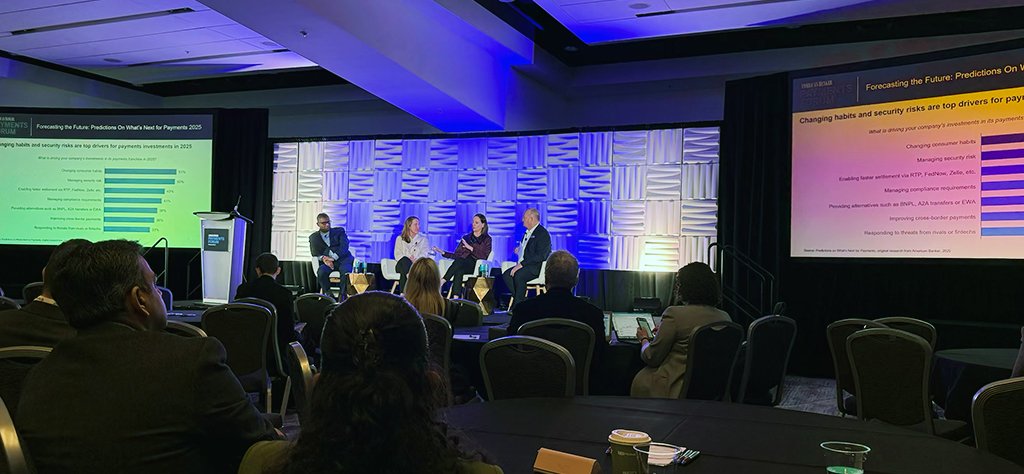Reflections on the American Banker Payment Forum
This past week, I had the privilege of attending the American Banker Payment Forum in San Francisco, California. This gathering of industry leaders, financial institutions, fintech, payment processors, and acquirers was particularly noteworthy because of the strong representation of women driving innovation, shaping strategy, and redefining the future of payments.
In the article below, I highlight key themes, well-executed aspects of the forum, and emerging trends that will continue to shape the payments landscape in 2025.
Celebrating Women Leaders in Payments
One of the most inspiring aspects of the event was the Most Influential Women In Payments Conference, which recognized women who are profoundly impacting the payments ecosystem—through leadership, execution, influence, and mentorship. These industry trailblazers are shaping strategy and championing innovation and inclusivity.
Among the notable speakers were:
Sarah Walsh, Head of Vendor & Third-Party Network Relationship Management, Bank of America
Yaminah Sattarian, SVP, Group Leader, KeyBank
Taira Hall, EVP, Enterprise Payments, Citizens Bank
Kate Moran, VP, Global Payments, Banking & International Expansion, Flywire
Ann Drew, Chief Risk & Compliance Officer, WEX
This emphasis on female payment leadership is more than just symbolic—it reflects the increasing influence of diverse perspectives in shaping the industry’s future.
The Power of Data in Payments (Keynote)
A recurring theme throughout the forum was data-driven transformation. Every discussion provided a different angle on the value of data, its potential, and how to harness it effectively.
For Michael Rutledge, CIO and Head of Technology Services at Citizens Financial Group, the focus is on:
Enhancing the payment experience—seamless, intuitive, and personalized.
Expanding payment distribution—broadening accessibility and scalability.
Modernizing infrastructure—future-proofing platforms for agility and resilience.
To achieve this, organizations must prioritize:
Strengthening API frameworks for seamless integration.
Accelerating cloud adoption to enable scalability and innovation.
Rationalizing legacy systems to support real-time, always-available payments.
With open banking on the rise, data will be at the heart of a more connected, efficient, and intelligent payments ecosystem.
Embedded Finance: Reshaping Industries (Panel)
Embedded Finance continues to redefine traditional business models, creating frictionless financial experiences across industries. A standout panel explored the profound impact of embedded payments, with Lia Cao, Global Head of Embedded Finance at JPMorgan, outlining its primary applications:
Horizontal platforms: Marketplaces like eBay and Etsy integrate seamless payment solutions.
Vertical-specific solutions: Companies like Toast are revolutionizing restaurant payments.
Healthcare payments: A high-value, compliance-intensive sector that demands secure, HIPAA-compliant solutions.
As embedded finance expands, it blurs the lines between financial services and commerce, making payments an invisible yet indispensable part of daily transactions.
Key Themes for Payments in 2025 (Panel)
A critical panel featuring Molly Hugar (SVP, KeyBank), Tiffany Patrick (Director of Global AML Payments, Citi), and Nageswar Cherukupalli (SVP, Cognizant) provided compelling insights into where payments are headed.
The key trends shaping the industry in 2025 include:
AI and Automation in Payments Innovation
Generative AI and automation are transforming payments—but rather than replacing human expertise, AI amplifies decision-making and streamlines operations. Key areas where AI is driving change:
• Faster product development—reducing time-to-market for innovative payment solutions.
• Personalized customer interactions—AI-powered insights enhancing user experiences.
• Advanced fraud detection—real-time analytics strengthening security measures.
However, explainability, auditability, and regulatory compliance remain critical. Organizations must ensure that AI-powered tools are transparent, accountable, and easily interpretable for both regulators and stakeholders.
Compliance and Regulatory Transparency
With regulatory scrutiny increasing, organizations must prioritize:
• Robust governance structures to ensure payment innovations meet compliance standards.
• Proactive risk controls to mitigate potential regulatory roadblocks.
• Clear, audit-ready frameworks that articulate payment strategies concisely.
In an era of evolving regulations, organizations must be prepared to justify their technologies to both regulators and internal governance bodies—whether in a boardroom presentation or an elevator pitch.
The Acceleration of Real-Time and Embedded Payments
The payments ecosystem is rapidly shifting toward instant, embedded, and seamless transactions. Key developments include:
• The rise of embedded finance, reducing reliance on third-party processors.
• Faster settlement speeds, making real-time transactions the new standard.
• Increased blockchain adoption, particularly in cross-border payments, despite regulatory uncertainties.
Strengthening Fraud Prevention and Cybersecurity
As digital payments grow, so do fraud risks. Organizations are leveraging AI-driven security to detect and mitigate threats in real time. The focus areas include:
• Adaptive fraud prevention models that analyze transaction patterns.
• Biometric authentication & multi-factor security to enhance identity verification.
• Cyber-resilience strategies, with closer collaboration between financial institutions and regulators.
Collaboration and Ecosystem Partnerships
The future of payments is built on collaboration, not competition. Key areas to watch:
• Open banking evolution, enabling seamless API integrations.
• Stronger bank-fintech partnerships, combining agility with scale.
• Improvements in cross-border payments, making international transactions faster, cheaper, and more transparent.
Final Thoughts: Where Payments Are Headed
A combination of AI-driven innovation, regulatory transparency, real-time processing, and fraud prevention will shape the payments industry in 2025. Organizations that:
✔️ Prioritize compliance and security
✔️ Enhance user experience through embedded finance
✔️ Leverage AI responsibly and explainable
… will be best positioned for success.
The American Banker Payment Forum reinforced the urgency of modernization. As we move forward, the industry’s focus will remain on:
Enhancing user experiences
Driving financial inclusion
Preparing for an increasingly digital and real-time payment landscape
The future of payments is not just about technology—it’s about trust, transparency, and transformation.
The American Banker Payment Forum reinforced a critical question:
➡ Are we moving fast enough to modernize payments while keeping trust at the core?
I’d love to hear your thoughts—what trends stood out to you? What challenges must the industry overcome next?
Sign up for a FREE consultation on how fintechs and banks can co-create value.


